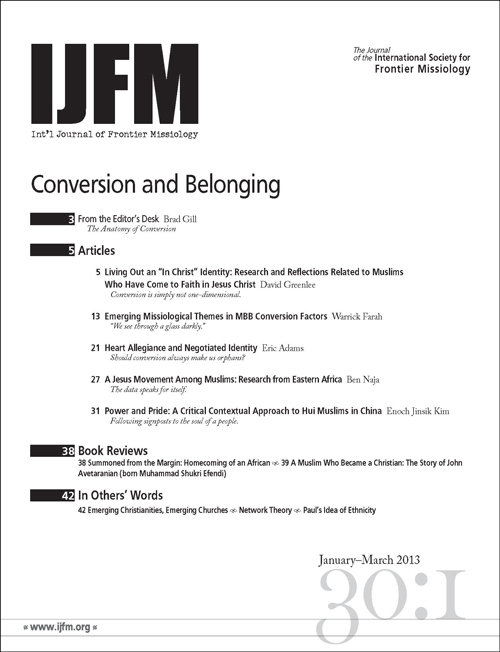 In this post we move on from the introduction and consider the first theme of factors that are influencing Muslims to embrace Biblical faith (from this article):
In this post we move on from the introduction and consider the first theme of factors that are influencing Muslims to embrace Biblical faith (from this article):
1. Conversion is a Contextual Process
Conversion and regeneration are two sides of the same coin (Stott 2008, 169). While united, the two are easily and often confused. There are three reasons the distinction between regeneration and conversion is necessary: (1) regeneration is God’s act, whereas conversion is man’s response, (2) regeneration is unconscious, whereas conversion is normally conscious, (3) regeneration is an instantaneous and complete work of God, whereas conversion is more a process than an event (168-171).
James Engle notes that although conversion can be regarded as sudden, unconscious, or gradual, gradual conversion is the most common form of conversion for those in unreached, non-Christian areas who come to Christ. Conversion “may climax in what appears to be sudden conversion, but the act of turning or decision is secondary to the process itself” (1990).
The idea that conversion is only an event (i.e., “one-step decisionism” (Conn 1979, 101)) is deeply embedded in the evangelical mind, and is a result of a “punctiliar” emphasis on conversion from the “revivals” in Protestantism during the seventeenth and eighteenth centuries (Smith 2010, 1-20). Although rare, point-in-time conversion experiences are more common in Christian societies than in non-Christian societies where one could have a “revival” experience (Lutz 2007).
The overall experience of Muslims, however, is that conversion is a gradual process that takes place over many years (Haney 2010, 68; Larson 1996a; Teeter 1990, 307-308). Gordon Smith notes that Muslim conversions to Christ “do not tend to rest or pivot on a decision or a particular act of acceptance. Rather, it has been well documented that these conversions are slow and incremental” (2010, 84). Qaasid cannot point to the moment of his conversion, but he knows he is a disciple of the Messiah. Thus, conversion is a process that transpires over months or years. The sometimes apparently sudden decision to “follow Christ” is only one essential step in this process.
Yet the context where conversion happens plays a key role. Two million Muslims in Java converted to Christianity in the 1960s (Willis 1977). Initially, this began as a protest against tribal and village Muslim leaders in the aftermath of a massacre of communists by fellow Muslims; many of the converts had communist family members who had been killed by Muslims. “What had begun as an act of political rebellion…eventually took on a deeper meaning” (Hefner 1993, 117). These converts were further drawn into conversion by an experiential, personal encounter with Christ through prayer and Bible study that “had no precedent in the traditional village religion” (1993, 116).
Furthermore, when these converts professed faith officially, they did so without understanding the fuller consequences of their decision. “Public profession of the faith had inspired an interior rationalization quite unlike anything that would have occurred on a purely individual basis” (Hefner 1993, 120). Eventually the converts came to realize that many of “their local traditions [were] incompatible with their new Christian faith” (1993, 122).
Finally, the “social psychology” of the Javanese context in the 1970s had finally cleared away the perception that Christianity was a foreign (Dutch) religion thus making conversion more possible on a wider scale. The Javanese were, to some extent, “able to establish a free space in which conversion would not immediately result in severe social stigmatization” (1993, 120). In the conversion process, political motivations and social stigmas concerning religious identity are important contextual factors. This Java case study demonstrates the importance of context: genuine conversion does not always begin with spiritual or intellectual motives.
I understand the the phrase “contextual process” might sound awkward. My point is to emphasize two items: 1) that in each place where Muslims come to faith there are going to be unique factors that influence them (we have to get beyond the cookie-cutter, one-size-fits-all, lazy kind of missiology that says if you just do A + B + C you will be fruitful), and 2) that conversion is a gradual process (this should really challenge you if you believe evangelism = getting people to the “sinner’s prayer”).
So what are the implications for kingdom witness among Muslims?
1. Conversion is a Contextual Process – Kingdom workers are only one expendable step in the process of conversion. This should promote both humility and anticipation. God is at work long before we “show up,” but He does use us.
Can you think of other implications? There should be many. How does the Arab Spring fit in? Think of Java above. Please comment and feel free to disagree. Stay tuned for part 2, “The Prominence of the Affective Dimension.”











